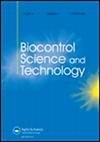拟寄生物对荔枝瘿蚊的发生及防制潜力(双翅目:瘿蚊科)
IF 1.2
4区 农林科学
Q4 BIOTECHNOLOGY & APPLIED MICROBIOLOGY
引用次数: 0
摘要
荔枝是亚热带地区重要的经济果树。荔枝害虫杨氏荔枝和罗氏荔枝在荔枝作物叶片上引起水疱疮,造成产量损失。虽然化学防治可以有效地抑制害虫种群,但应考虑杀虫剂抗性和环境影响。采用害虫综合治理(IPM)技术防治荔枝瘿蚊是一种较为环保的防治策略。本文调查了寄生胡蜂在台湾羊草上的分布和发生情况,以了解其生物防治潜力。结果共发现11种寄生蜂,其中5种为寄生蜂的天敌:approstocetus sp.、Bracon sp.、derostus sp.和2种已知的Quadrastichus,其余6种寄生蜂(Aphanogmus sp.、Cirrospilus sp.、Eupelmus sp. 2种、Gonatocerus sp.和Quadrastichus sp.)的寄主和生物学不确定,但也在瘿内发现。此外,约翰拉萨莱在台湾5个取样地的寄生率最高,在其他5个随机取样地也普遍存在,被认为是最好的生物防治剂。寄生蜂的寄生率与温度和降雨两种非生物因子不相关,说明寄生蜂对各种环境具有较强的适应性。本文报道了五种羊草寄生天敌的基本生物学和分布信息,为进一步开展羊草的生物防治工作提供了依据。本文章由计算机程序翻译,如有差异,请以英文原文为准。
Occurrence and biocontrol potential of parasitoids on lychee cecid pest, Litchiomyia chinensis (Diptera: Cecidomyiidae)
ABSTRACT Lychee is an economically important fruit tree in sub-tropical area. The lychee pest, Litchiomyia chinensis Yang and Luo, induces blister-galls on the leaves of lychee crop and causes yield losses. Although chemical control may effectively suppress the pest population, insecticide resistance and environmental impact should be considered. It is preferable to develop more eco-friendly tactics using Integrated Pest Management (IPM) on lychee gall midges. The distribution and occurrence of parasitic wasps on L. chinensis in Taiwan were investigated to understand their biocontrol potential. As a result, 11 parasitoids were found, and five species of them were confirmed as parasitic natural enemy of the pest cecid: Aprostocetus sp., Bracon sp., Derostenus sp., and two known Quadrastichus spp. Host and biology of the remaining six parasitoids (Aphanogmus sp., Cirrospilus sp., two Eupelmus spp., Gonatocerus sp. and Quadrastichus sp.) are uncertain, although they were also found inside gall. Besides, Q. johnlasallei is considered as the best biocontrol agent as it displays the highest parasitism in all five sampling localities and commonly found in the other five randomly collected localities of Taiwan. Noncorrelation between parasitism of Q. johnlasallei and two abiotic factors (temperature and rainfall) suggested its high adaptability in various environment. Fundamental biological and distribution information of five parasitic natural enemies of L. chinensis reported herein will be helpful for further developing its biocontrol programme.
求助全文
通过发布文献求助,成功后即可免费获取论文全文。
去求助
来源期刊
CiteScore
3.20
自引率
7.10%
发文量
64
审稿时长
4-8 weeks
期刊介绍:
Biocontrol Science and Technology presents original research and reviews in the fields of biological pest, disease and weed control. The journal covers the following areas:
Animal pest control by natural enemies
Biocontrol of plant diseases
Weed biocontrol
''Classical'' biocontrol
Augmentative releases of natural enemies
Quality control of beneficial organisms
Microbial pesticides
Properties of biocontrol agents, modes of actions and methods of application
Physiology and behaviour of biocontrol agents and their interaction with hosts
Pest and natural enemy dynamics, and simulation modelling
Genetic improvement of natural enemies including genetic manipulation
Natural enemy production, formulation, distribution and release methods
Environmental impact studies
Releases of selected and/or genetically manipulated organisms
Safety testing
The role of biocontrol methods in integrated crop protection
Conservation and enhancement of natural enemy populations
Effects of pesticides on biocontrol organisms
Biocontrol legislation and policy, registration and commercialization.

 求助内容:
求助内容: 应助结果提醒方式:
应助结果提醒方式:


